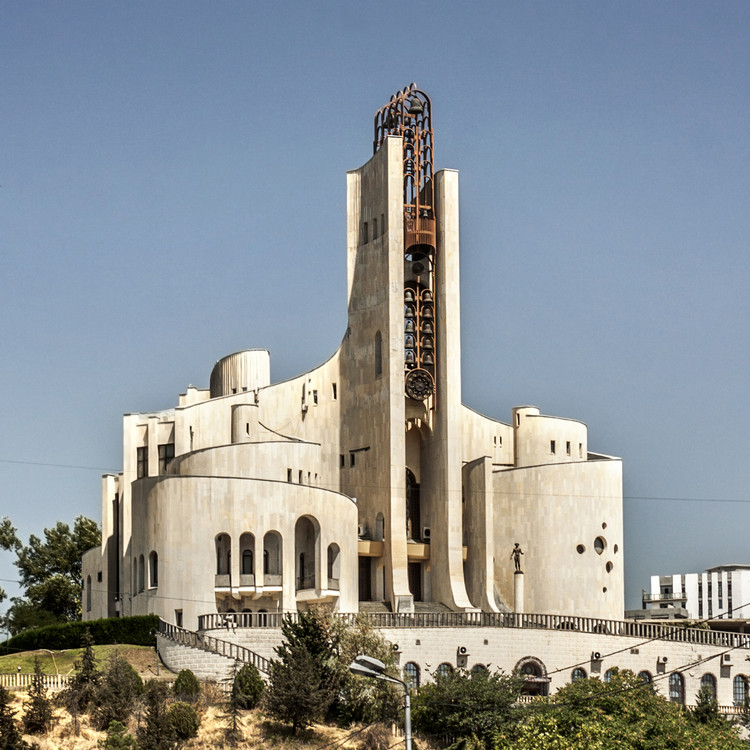
The Republic of Georgia’s past is defined by turbulence and a struggle for identity. A former republic of the USSR, Georgia is perhaps best known as the birthplace of Joseph Stalin. The nation's history has been anything but calm, and remnants of the architectural past provide a glimpse into the nation that was.
The country's remaining Soviet landmarks give Georgia an air of being caught between the past and the present. Italian photographers Roberto Conte and Stefano Perego capture this in their photo series, Soviet Architecture Heritage in Georgia, with a compilation of photos that highlights the existing Soviet heritage in Georgian architecture today.

Dating back to the 1st century, the modern-day Georgian capital, Tbilisi, existed as an important trading point on the Eurasian Steppe Route, a precursor to the Great Silk Road. Mongol, Persian, and Ottoman empires surrounded the area, and because Tbilisi was also the Christian outpost in the region, the city repeatedly suffered from invasions by their hostile Islamic neighbors [1]. By the late 18th century, the capital was in ruins.

In 1921, Russians intervened in Tbilisi and cut Georgia’s Islamic ties, declaring the fragile nation as a Soviet state. Architecture became one of the Soviets' key tools to exercise their ideology. The city of Tbilisi was regulated by masterplans, and monuments and buildings glorifying the Soviet Union surfaced on every street corner.

Although the Soviet Union fell in 1991, their monuments survived. Constant reminders of the country’s Soviet past remained and populated the country's built environment. After the fall, Georgia reverted to being a weak, unstable state. The country struggled through the arduous process of seceding from Russia and forming an independent nation. A wave of civil wars and political strikes swept through the area and left the country, once again, in ruins [2].

Today, remnants of a Soviet-occupied Georgia are still scattered throughout the country. Conte and Perego traveled throughout Georgia to locate these Brutalist and Constructivist landmarks. Although the country has tried to modernize and forget the past, the Italian photographers view Georgia’s Soviet architecture as an important feature of the country’s urban landscape. Many examples of Georgia's Soviet architecture, including Andropov's Ears, have been destroyed. Others remain, however, and have been renovated to take on a new form.

Conte and Perego use their images to bring attention to the expressionist style apparent in the country’s Soviet architecture. This can be seen in the use of human forms in the statue by Berdzenishvili in Marneuli and Russian Georgian Friendship Monument near the Georgian border. Human forms also appear in murals painted on the side of many Soviet public buildings, such as the Auditorium of the Industrial Technical College or the Archeological Museum.

The Archaeological Museum also exhibits the use of an almost circular plan. This was a common design decision in many examples of Georgian Soviet architecture and can also be seen at the Djorbenadze’s Palace of Rituals.

An important Soviet landmark was the Iberia Hotel. Constructed in 1967, it was later transformed by Georgian architects G. Chakhava and Z. Jalghania. The building's exterior was completely altered and today is being used as a Radisson Blu Hotel.
The pair was especially interested in the Ministry of Highway Construction. This particular project was the culmination of a fusion of several architectural influences of the Georgian past—traditional Georgian architecture roofs, metabolist utopias, and the horizontal skyscrapers of El Lissitzky. The structure has also been restored and converted—today, it serves as the Bank of Georgia's headquarters.

Although the Republic of Georgia strives to advance to modern society, Conte and Perego choose to highlight the past. The Brutalist and Constructivist monuments which continue to occupy much of Georgia’s landscape offer a brief glance into a small part of the nation's long history. The fragments which remain serve as reminders and reflections of the urban conditions of the Soviet era.

References:
- Shavishvili, Nick. "View from Tbilisi." The Architectural Review 213, no. 1275 (05, 2003): 32
- Ibid.
















